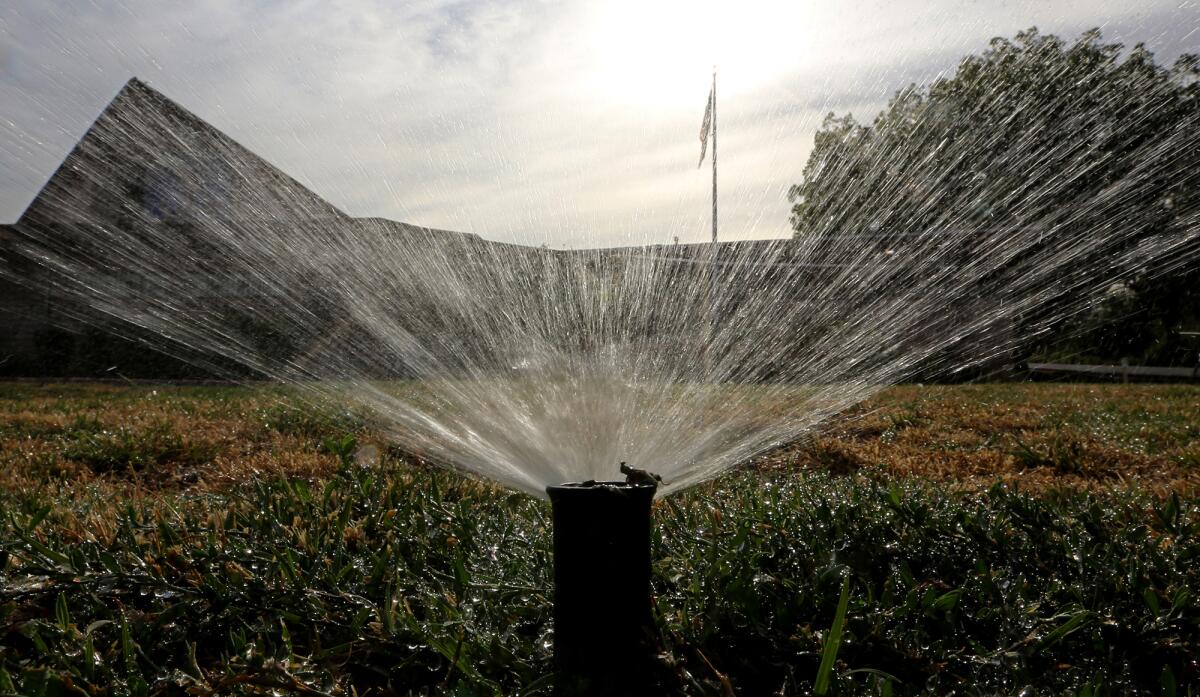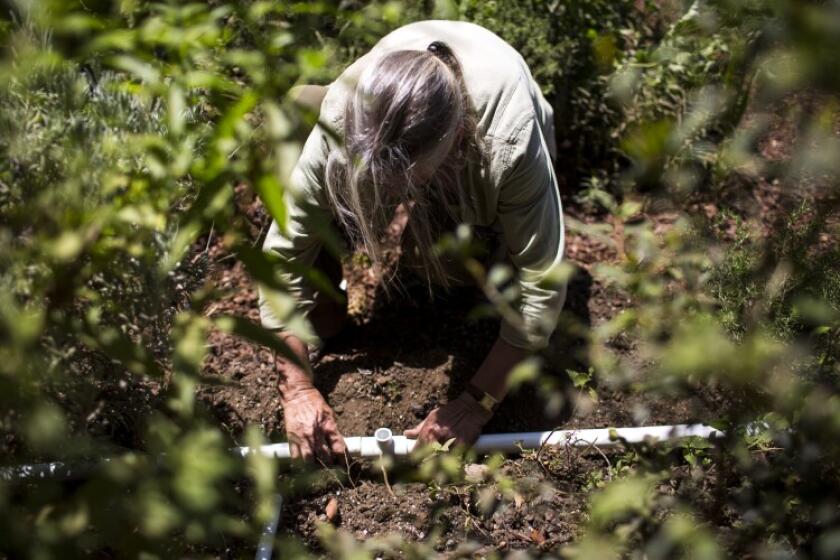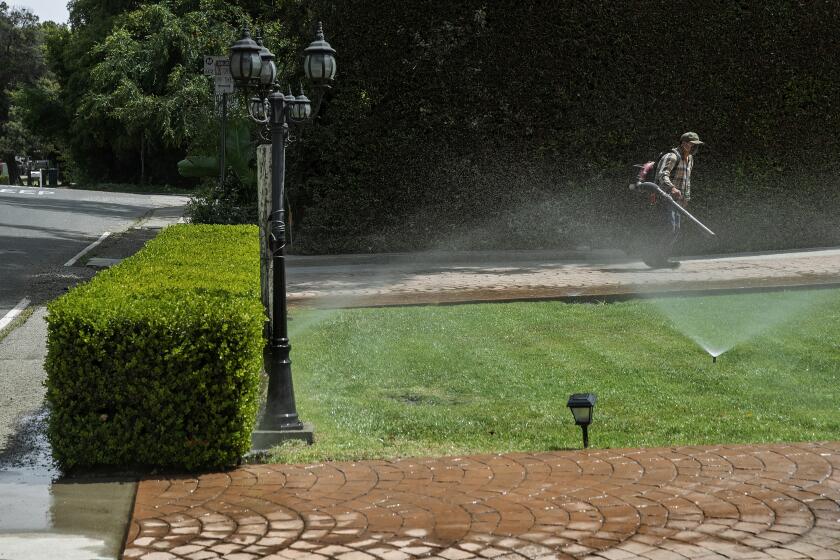More water restrictions are coming to Southern California. How to conserve

- Share via
With the news that Southern California officials are imposing tough water-use restrictions on about 6 million people, many of us are looking for practical ways to conserve.
We’ve all been through this drill so many times, as some of the obvious water-saving steps have become almost second nature. Less lawn-watering. Shorter showers. Fewer flushes.
But as you go about trimming your water usage at home, experts warn that nips and tucks alone can’t get us out of the multiyear drought we’re in.
One reason is that residential users represent a pretty small slice of the water-usage pie. About 80% of water used in the state goes toward agriculture, Kelly Sanders, associate professor of civil and environmental engineering at USC, told The Times last year. The other 20% is urban usage, she said, which is split roughly in half between indoor and outdoor use.
“While individual actions are essential for addressing huge environmental issues like climate change and drought, they’re always insufficient,” Jason Mark, an editor at the Sierra Club magazine Sierra, told The Times last year. He described it as “addition where we need multiplication.” That multiplication comes in the form of better public policy, pressure on government officials to address these issues and lifestyle changes to reduce reliance on water-intensive products and plants.
With that in mind, here are some tips for saving water with things that are under your control — plus an idea for changing how you think about water and what that might mean in your life.
The water that cleans your clothes isn’t safe to drink, but it could be good for your plants. Here’s how to use grey water amid drought restrictions.
1. Rip out your lawn
Or at least sprinkle dramatically less water on it. Californians’ frontyards became a major focus of the 2016 water reduction campaign. There’s a reason for that: They’re lush and water-intensive. Heather Cooley of the Pacific Institute, a think tank that identifies and advances sustainable water policies, told The Times last year that watering the average lawn in Southern California uses about 40 to 80 gallons. Comparatively, she said, turning off the faucet while you brush your teeth saves four to five gallons, and chopping two minutes off your shower time saves five.
2. Replace non-native plants
Beyond your lawn, plants that aren’t native to Southern California probably take up more water than ones that evolved to thrive here. You have lots of options. And as a bonus, natives help the birds and the bees.
Finding your favorite nursery can be thrilling. Here are our picks for the best independently owned plant nurseries near Los Angeles.
3. Find and fix leaks
Keep an eye on your water bill. If it creeps higher than normal without a good reason, investigate whether you have a leak somewhere. Depending on the type of water meter you have, you may be able to monitor the meter with all your water turned off and see whether anything is still moving through your system. You may also want to invest in a smart leak detector to tell you right away when there’s a problem.
4. Replace old appliances, showerheads and toilets
How old is your toilet? If it’s from before 1990, Cooley said, it could be using up to six gallons per flush. Newer toilets may use 1.28 gallons or less. Cooley said they can save 33 gallons per household per day. And a new shower head can save 12. Upgrading your dishwasher, washing machine and any other water-intensive appliances also will pay savings dividends, in both water and energy costs, Cooley said.
5. Small things can add up
You’ve probably heard these tips before, but consider this a refresher course:
- Don’t let the water run while you wash dishes in the sink or while washing, brushing or shaving.
- Run washing machines and dishwashers only when you have a full load.
- Make peace with the layer of dust on your car.
- If you’re waiting for the shower to warm up, stick a bucket in it and use that water on your houseplants.
- Double-check that your sprinkler system isn’t watering your driveway.
- Use a broom instead of a hose to clean off porches, sidewalks and driveways.
- Water outdoor plants in the morning or evening so you don’t lose as much H2O to evaporation in the midday sun.
Drought-resistant plants like hummingbird sage and rosemary are the ideal addition to Southern California gardens.
And now, a bigger picture
There are ways to save water that don’t directly involve your home usage.
“One of the things that people can do that’s a little bit more nebulous is to think about their indirect water footprint,” Sanders said. “‘How much water is embedded in the products that I buy? How much water is required to irrigate the fruits and vegetables that I’m eating?’ Meat, beef in particular, is a high-resource food. It takes a lot of water to get a cow from the beginning of its life to the end of its life. It’s a lot of food that has to be irrigated.”
(She added, though, that some of the criticism of agriculture isn’t fair. We do need to eat, after all, and some water-intensive crops, such as almonds, are economically important to the state.)
So think carefully about what you consume, both in terms of what goes into your mouth and onto your body. A new cotton T-shirt consumes more than 650 gallons of water on its way to existence. A pound of plastic takes 22. Manufacturing a new smartphone requires more than 3,000. It takes more water to make a one-liter single-use plastic water bottle than that bottle can hold.
Again, those choices will save water but not solve the larger problem. Ultimately, the most meaningful changes are going to come from political action. Ask your local and state officials to back water-saving legislation and to enforce it once it passes. Attend a city council meeting and ask what your community’s plans are to improve water conservation. You can start even smaller than that: Ask your homeowners association to replace lawns with native plants. Submit letters to the editor of your local newspaper about the issues you see in your community. (Here’s how to send one to us.)
“We should — both as individuals, as households — do everything within our power to use less water, use less electricity, use fewer fossil fuels,” Mark said, and “at the same time, do everything that’s within our ability to convince those in power to change the rules of the game.”
So be the drop in the proverbial bucket. Then use that bucket to water your plants.
Areas that get water from the Colorado River or other sources will be spared from restrictions, at least for now. The strategy has divided experts.













